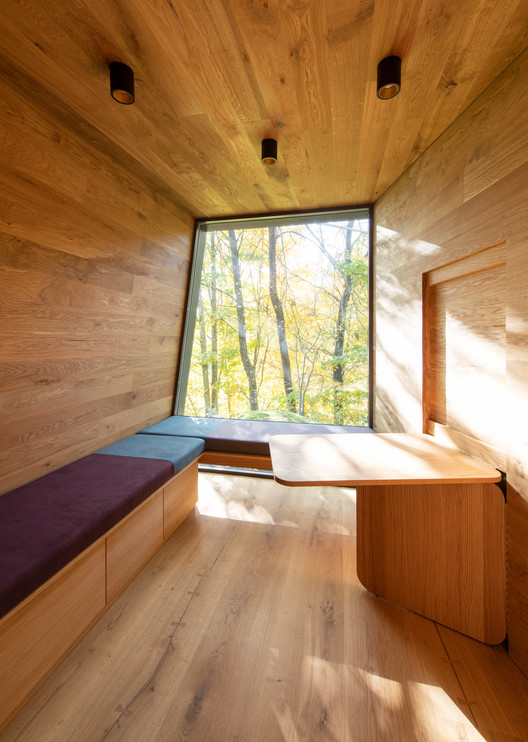LCC ACXT
2017-01-03 12:00
© Aitor Ortiz
C.Aitor Ortiz


架构师提供的文本描述。秘鲁与世界银行和国际货币基金组织就2015年理事会在利马举行会议达成的协议,使利马会议中心的项目和建设成为背景。
Text description provided by the architects. The project and construction of the Lima Convention Centre (LCC) is contextualized by the agreement between the Peruvian State and the World Bank and the International Monetary Fund to hold in Lima the 2015 Board of Governors.
© Aitor Ortiz
C.Aitor Ortiz


LCC的战略位置位于国家文化中心(CCN)-毗邻国家博物馆、教育部、国家银行新总部或Huaca San Borja-LCC的设计是为了满足四个战略目标:成为国家的文化和经济发动机,代表植根于秘鲁集体文化的城市中心的一个会议场所,成为一个独特的、灵活的、技术先进的建筑地标,最终触发CNN及其周边地区的城市转型。
Strategically located in the Cultural Centre of the Nation (CCN) – next to the National Museum, the Ministry of Education, the new headquarters of the National Bank or the Huaca San Borja – the design of the LCC was to satisfy four strategic objectives: being a cultural and economic motor for the country, representing a meeting place at the heart of the city enrooted in the collective Peruvian culture, turning into a unique, flexible and technologically advanced architectonic landmark and finally, triggering the urban transformation of the CNN and its surroundings.
© Aitor Ortiz
C.Aitor Ortiz


近15,000平方米的净面积相当于18个多用途会议厅,其大小和比例从3,500平方米到100平方米不等,允许多达10,000人同时参加活动。其余部分由四层地下停车场以及地面上的几个辅助会议室完成。这些领域将包括该中心的翻译和一般管理领域、仓库和厕所、车间和维修和材料分发区、厨房和餐厅、展览厅、自助餐厅和休闲区。所有这些都产生了86,000平方米的总建筑面积。
The near 15,000 m2 of net area correspond to the 18 multipurpose convention halls, their sizes and proportions varying from 3,500 m2 to 100 m2, which allow for up to 10,000 people to attend simultaneous events. The rest of the programme is completed by four underground car-park floors as well as several uses above ground that complement the conference rooms. These would include areas for translation and general management of the centre, stockrooms and toilets, workshops and areas for maintenance and material distribution, kitchens and dining areas, exhibition halls, cafeterias and relaxation areas. This all generates a total built up area of 86,000 m2.
© Aitor Ortiz
C.Aitor Ortiz


城市提案位于北端的建筑入口,因此鼓励了文化大道的未来发展。一般卷分为三个时间物理层,与国家的历史、时间和记忆具有象征性的联系:
The urban proposal situates the access to the building on the north end, therefore encouraging the future development of the Culture Boulevard. The general volume is organized into three time-physical strata clearly differentiated, symbolically related to the country’s history, time and memory:
现在的代表是巨大的内部空隙-国家房间-其中两间可转换的房间约1800平方米,其中一间可以完全向城市开放,清理它周围的音响面板,形成一个超过2500平方米的有遮蔽的城市广场。
The present is represented by the great internal void – Nation Rooms – which harbours the two transformable rooms of about 1,800 m2, one of which can open up entirely to the city by clearing its perimeter of the acoustics panels that make it up, generating a sheltered urban plaza over 2,500 m2.
© Aitor Ortiz
C.Aitor Ortiz


© Aitor Ortiz
C.Aitor Ortiz


过去,这个项目的核心,是一个户外区域,灵感来自一个巨大的瓦卡-利马休息室-自然产生的性格和不同的高度的会议大厅。
The past, the heart of the project, is an outdoor area inspired by a great huaca – Lima Lounge – generated naturally by the disposition and the difference in height of the convention halls.
Cross Section


Cross Section


未来是一部精力充沛的巨著-国际国库。这是一个技术含量很高的会议设施,邀请世界其他国家来秘鲁,因为它的创业能力和充满希望的未来。
The future is a great vitreous volume – International Room of Nations. It’s a highly technical conventions facility which invites the rest of the world to come to Peru for its entrepreneurial capacity and its promising future.
© Aitor Ortiz
C.Aitor Ortiz


操作上和功能上的灵活性是LCC全面设计的关键,其目标是最大限度地实现项目的经济和社会成功。由于声学面板的限制,几乎所有的房间都可以扩展或缩小,使得有可能有几个空间分布。
The operative and functional flexibility are keys to the comprehensive design of the LCC and are orientated towards maximizing the economic and social success of the project. Nearly all rooms can be extended or reduced thanks to the acoustic panels that limit them, making it possible to have several spatial distributions.
© Aitor Ortiz
C.Aitor Ortiz


从技术上讲,5400平方米(可容纳3500人)的大房间必须没有柱子-加上使用支撑结构带来的地震不便-的强制性条件,这就把概念和结构提案变成了一项挑战,因为这意味着要把大空间放在最后一层。在30米以上的高度放置足球场那么大的遮蔽空间,对建筑物的结构方式和内部流动性-出入和疏散都是一个挑战。
Technically, the mandatory condition by which the great 5,400 m2 room, with capacity for 3,500 people, was to be free from pillars – along with the seismic inconvenience of using propped up structures –, turns the conceptual and structural proposal into a challenge, since it implies putting the great room on the last level. Placing a sheltered volume the size of a football pitch at a height of over 30 m is a challenge to both the structural approach and the building’s internal mobility – access and evacuation.
© Aitor Ortiz
C.Aitor Ortiz


























































































Architects IDOM
Location San Borja, Peru
Category Cultural Center
Architects in Charge Tono Fernández Usón, César Azcárate, Javier Álvarez de Tomás
Project Management Javier Álvarez de Tomás
Area 86000.0 m2
Project Year 2016
Photographs Aitor Ortiz
Manufacturers Loading...































